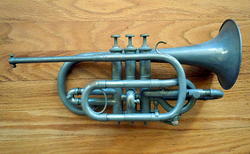Cornet in A - Marceau & Cie, Paris
The Horn of the Month, September 2015, is a cornet in “A” stamped Marceau & Cie Paris. This instrument is a sturdy brass nickel-silver plated cornet. This is another of my early “finds” that began my instrument collection. This instrument was found at a “yard sale” on Long Island, New York around 1970 by my mother (a different “yard sale” than mentioned on last month’s Horn of the Month). The inscription on the bell of the cornet reads in 2 lines- Marceau & Cie/ Paris. The valves are Périnet piston valves, three of them (valves are in the standard configuration: whole step, half step, step and a half). The lead pipe section is removable to change the key of the cornet. Only the “A” tuning shank was present at the time of purchase, but interestingly the cornet came with the small wooden case. The valve casings are numbered 139, 140, and 141. On the 2nd valve below the valve/piston number 140 is the number 7. On the reverse side of the 2nd valve, the letter “P” appears. There is no serial number. The cornet does have a double water key, lyre attachment mechanism and some moderate decorative ferrules. Although An Index of Musical Wind Instrument Makers by Lyndesay G. Langwill does list a Pierre Marceau & Cie in Paris as being a supplier to Sears Roebuck & Co.(page 114, Fifth Ed 1977); the Supplement to The Cornet Compendium, The History and Development of the Nineteenth-Century Cornet by Richard I. Schwartz states that a newer edition by William Waterhouse of the Langwill book (1993 pg 252) places the Marceau & Cie instruments to having been made in “an area later to become Czecholovakia” and that the “Paris” designation to be somewhat mis-leading. It would be listed for about $9.00 and the “A” tuning shank would have cost an additional 20 cents. My “find” did not have the “Bb” shank, the mouthpiece or any clues about who had owned the instrument. According to Mr. Schwartz, the Sears catalog of 1900 had 5 models of Marceau & Cie cornets being offered. The later catalog of 1908 describes Marceau cornets as being “heavily engraved”; mine unfortunately does not have any engraving. So, a possible circa “1900” cornet that never cost very much, has found a place to live at my house. This instrument affords me the opportunity to practice solos and various repertoires on an “A” cornet. I get to hear a different timbre and it changes how I think about the sound I want to produce. That said, it also makes me appreciate greatly the wonderful modern cornets that I use in performances. The phrase “the wand choses the wizard” comes to mind.
Of Interest
Périnet valves- On the Early History of the Pérnet Valve- Eugenia Mitroulia, Géry Dumoulin and Niles Eldredge
http://www.jstor.org/stable/25163935?seq=1#page_scan_tab_contents
The Cornet Compendium
http://www.angelfire.com/music2/thecornetcompendium/


 Back to List
Back to List